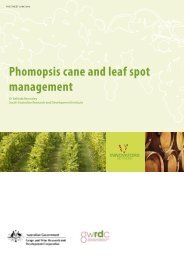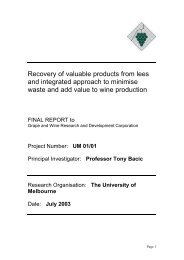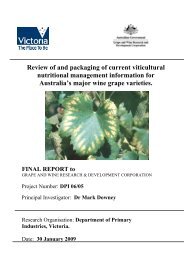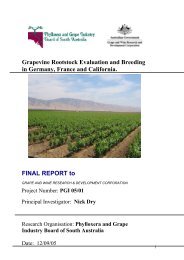Identification of the major drivers of 'phenolic' taste in ... - GWRDC
Identification of the major drivers of 'phenolic' taste in ... - GWRDC
Identification of the major drivers of 'phenolic' taste in ... - GWRDC
Create successful ePaper yourself
Turn your PDF publications into a flip-book with our unique Google optimized e-Paper software.
AWRI: <strong>Identification</strong> Of The Major Drivers Of ‘Phenolic’ Taste In White W<strong>in</strong>es<br />
Selection <strong>of</strong> Column<br />
A number <strong>of</strong> HPLC columns with different separations chemistries were screened us<strong>in</strong>g <strong>the</strong> 2009<br />
Chardonnay or Riesl<strong>in</strong>g hard press<strong>in</strong>gs w<strong>in</strong>e. The choice <strong>of</strong> column for fur<strong>the</strong>r optimization was<br />
determ<strong>in</strong>ed by <strong>the</strong> maximum number <strong>of</strong> resolved peaks (obta<strong>in</strong>ed us<strong>in</strong>g standardized <strong>in</strong>tegration<br />
parameters) at 280 nm (all phenyl-conta<strong>in</strong><strong>in</strong>g compounds) and <strong>the</strong> peaks <strong>in</strong> which <strong>the</strong> absorbance was<br />
higher at 320 nm than at 280 nm (hydroxyc<strong>in</strong>namate-conta<strong>in</strong><strong>in</strong>g compounds). The <strong>in</strong>itial screen<strong>in</strong>g<br />
looked at different separation chemistries or column presentations: UDC Cholesterol (Cogent);<br />
Synergi Polar RP, Synergi Hydro RP, Gem<strong>in</strong>i C6-Phenyl, K<strong>in</strong>tex PFP (Phenomenex); Supelco<br />
Ascentis Phenyl (Sigma) Spherisorb Phenyl, XBridge (Waters).<br />
Throughout <strong>the</strong> experiments, 20 µL <strong>of</strong> <strong>the</strong> same w<strong>in</strong>e sample (2009 Riesl<strong>in</strong>g hard press<strong>in</strong>gs w<strong>in</strong>e),<br />
stored at -18°C was <strong>in</strong>jected. Standardised <strong>in</strong>tegration parameters were used to assess <strong>the</strong> number <strong>of</strong><br />
peaks result<strong>in</strong>g for <strong>the</strong> different columns or operat<strong>in</strong>g conditions: slope sensitivity = 1; peak width =<br />
0.2 m<strong>in</strong>; area reject = 50 mAu; height reject = 5 mAu. The total number <strong>of</strong> peaks at 280 nm was<br />
recorded as was <strong>the</strong> number <strong>of</strong> peaks where <strong>the</strong> absorbance at 320 nm was greater than that at 280 nm<br />
which represented <strong>the</strong> hydroxyc<strong>in</strong>namates.<br />
A.3.3 Results and Discussion<br />
The success <strong>of</strong> column selection was measured <strong>in</strong> terms <strong>of</strong> <strong>the</strong> total number <strong>of</strong> separate peaks<br />
observed at 280 nm and peaks aris<strong>in</strong>g from hydroxyc<strong>in</strong>namoyl-conta<strong>in</strong><strong>in</strong>g compounds. Over 100<br />
separate peaks aris<strong>in</strong>g from phenolic compounds were detected. Of those columns studied, <strong>the</strong> Gem<strong>in</strong>i<br />
C6-Phenyl and K<strong>in</strong>tex PFP columns appeared to provide <strong>the</strong> highest degree <strong>of</strong> separation <strong>of</strong> phenolic<br />
compounds (Table A-1). As fur<strong>the</strong>r planned research will have require up-scal<strong>in</strong>g for semi-<br />
preparative separations for sensory analysis, <strong>the</strong> former column was chosen as more pack<strong>in</strong>g options<br />
were available at <strong>the</strong> time <strong>of</strong> this work.<br />
Optimization <strong>of</strong> Chromatography Us<strong>in</strong>g Gem<strong>in</strong>i C6-Phenyl Column.<br />
Fur<strong>the</strong>r optimization was carried out on <strong>the</strong> formic acid concentration and effect <strong>of</strong> TFA<br />
concentration. In order to improve <strong>the</strong> resolution <strong>of</strong> early-elut<strong>in</strong>g compounds, <strong>the</strong> pH was modified to<br />
be potentially below <strong>the</strong> pKa <strong>of</strong> some hydroxybenzoic or c<strong>in</strong>namic acids so that <strong>the</strong>y were<br />
predom<strong>in</strong>antly <strong>in</strong> <strong>the</strong> unionized form. This was carried out by <strong>in</strong>clud<strong>in</strong>g trifluoroacetic acid <strong>in</strong>to both<br />
mobile phases and also modulat<strong>in</strong>g <strong>the</strong> concentration <strong>of</strong> formic acid. In view <strong>of</strong> <strong>the</strong> complexity <strong>of</strong> <strong>the</strong><br />
chromatogram with <strong>the</strong> number <strong>of</strong> peaks elut<strong>in</strong>g, all dead volumes were m<strong>in</strong>imized by fitt<strong>in</strong>g <strong>the</strong><br />
shortest possible lengths <strong>of</strong> 0.12 mm i.d. sta<strong>in</strong>less steel tub<strong>in</strong>g from <strong>in</strong>jector seat to detector and us<strong>in</strong>g<br />
a semi-micro flow cell. A b<strong>in</strong>ary pump was <strong>in</strong>stalled <strong>in</strong>stead <strong>of</strong> <strong>the</strong> quaternary to m<strong>in</strong>imize pressure<br />
fluctuations. An <strong>in</strong>jection volume <strong>of</strong> 10 µL was also adopted as this slightly improved resolution <strong>of</strong><br />
peaks. The samples were matched to <strong>the</strong> start<strong>in</strong>g chromatography conditions by mak<strong>in</strong>g up samples to<br />
volume with 2% formic and 0.01% TFA. Both <strong>of</strong> <strong>the</strong>se measures improved <strong>the</strong> retention time<br />
variability. A typical HPLC-DAD chromatogram is shown <strong>in</strong> Figure A-1 with some <strong>of</strong> <strong>the</strong> <strong>major</strong><br />
peaks identified. The trace aris<strong>in</strong>g largely from benzoic acids, flavan-3-ols and o<strong>the</strong>r phenol- r<strong>in</strong>g<br />
conta<strong>in</strong><strong>in</strong>g compounds can be seen when A280 be<strong>in</strong>g <strong>the</strong> largest.<br />
104









